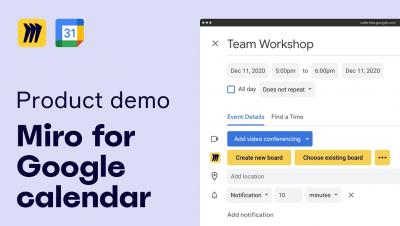Teams | Collaboration | Customer Service | Project Management
Miro
How not to do remote collaboration
Collaborating remotely has historically been a challenge — and now that so many more of us are home and interacting virtually, those challenges are more apparent than ever. Fortunately, Miro makes collaboration significantly more manageable. Simply put, collaboration is the act of working together to create something. It might be a website, a diagram of some kind, or a vision statement. The key is people coming together to work. But before Miro, there were other ways to collaborate online.
How expert facilitators run great online meetings in Miro
The perfect meeting is an elusive concept. We’re all familiar with the mind-numbing “I talk, you listen” model of the corporate presentation and the chaos of open-ended brainstorms with no clear takeaways. If our calendars are starting to look like brick walls of meeting blocks, this pattern can lead to frustration and burnout. It’s time to challenge the status quo and make meetings more efficient, engaging, and interactive.
How exactly can Miro impact a team? We asked our customers to find out
During his lifetime, Carl Sagan was known for many things. He was an astronomer, astrophysicist, television producer, screenwriter, and celebrity-thinker who made advanced astronomy accessible to the layman and opened the window to space for millions of people around the world. For those without the time to read one of his books, we can remember him through some of the quotes he left behind. One of my favorites goes like this: “Who are we, if not measured by our impact on others?
10 million cursors, working together in Miro
Today I’m excited to share that Miro has passed the incredible milestone of 10 million people who rely on our platform to bring their ideas to life. This number represents nearly 300% growth since March 1st, as millions of teams across the world have adopted Miro to stay connected and build engaged, collaborative cultures while working remotely.
Introducing Miro Experts: A hand-selected network to help customers solve visual collaboration challenges
Miro pioneered the collaboration market with its online whiteboard back in 2011 (as RealtimeBoard). Early adopters quickly got the benefits of getting together in front of PC screens and collaborating as if they were in the same room, but had trouble defining how to use it for work every day; or, what’s possible, and what’s not? As the solution was completely new, we joined those early enthusiasts in an exciting journey to establish online whiteboarding practices.
7 retrospective templates we love and use at Miro
I never thought I’d be such a huge fan of team retrospectives. I used to dismiss them as irrelevant for non-engineering teams, or as a twin of the post-mortem (which typically only takes place when something goes wrong, and too often involves feelings of regret and blame). But my attitude changed immediately when I started taking part in retros at Miro.
7 ways to organize your Miro board for productive workshops
Whether you are running a design sprint, defining your brand’s tone of voice, customer journey mapping with a remote team, or something else, there are any number of ways you can organize your Miro board. After all, you have an infinite canvas. Possibilities are endless. But how do you know where to start? Should you use a linear, circular, or more free-form layout? How can you use frames, templates, and color-blocking to give your attendees both structure and space to be creative?
How to fight back against remote meeting worst practices
The problem of too many redundant meetings isn't anything new. It is a trap many teams fall into, even in the office. It’s the trap of copious no-agenda, purpose-less meetings – and lots of them. But did you know that we’re actually having more meetings since going remote? According to a recent paper from the National Bureau of Economic Research, the average meeting count has gone from 5.9 meetings to 6.9. Yikes. Being remote, however, is helping us master meetings in a new way.
Introducing a new integration with Adobe XD and collaboration with Adobe
Bringing all the right people along the creative journey of designing new web and product experiences is complex. At each step, collaboration is imperative; from the birth of a creative idea, to conducting user research, through prototyping concepts there’s a chance for misalignment amongst the core design team, or with collaborators and clients.











